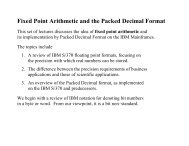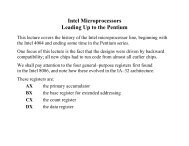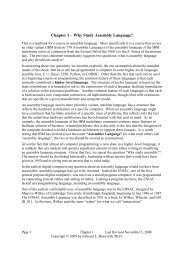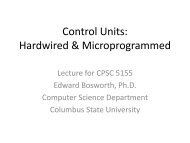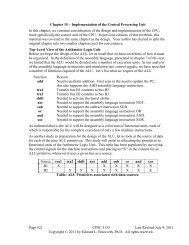Microprogramming: History and Evolution - Edwardbosworth.com
Microprogramming: History and Evolution - Edwardbosworth.com
Microprogramming: History and Evolution - Edwardbosworth.com
You also want an ePaper? Increase the reach of your titles
YUMPU automatically turns print PDFs into web optimized ePapers that Google loves.
Benefits of <strong>Microprogramming</strong><br />
As noted above, the primary impediment to adoption of microprogramming was that<br />
sufficiently fast control memory was not readily available.<br />
When the necessary memory became available, microprogramming became popular.<br />
The main advantage of microprogramming was that it h<strong>and</strong>led difficulties associated<br />
with virtual memory, especially those of restarting instructions after page faults.<br />
The IBM System 370 Model 138 implemented virtual memory entirely in microcode<br />
without any hardware support (Hennessy & Patterson, 1990).<br />
Here is a personal memory, dating from the early 1980’s. At that time <strong>com</strong>puters for the<br />
direct execution of the LISP programming language were popular, <strong>and</strong> there were two<br />
major <strong>com</strong>petitors: Symbolics <strong>and</strong> LMI.<br />
At a meeting in Austin, TX, the results of a benchmark <strong>com</strong>petition were announced.<br />
Early in the <strong>com</strong>petition, the LMI – 1 had fared poorly, running at about half of the speed<br />
of the Symbolics –3670. The LMI engineers immediately redesigned the control store<br />
to execute code found in the benchmark. By the <strong>com</strong>petition, the LMI – 1 was officially<br />
a bit faster than the Symbolics – 3670.



